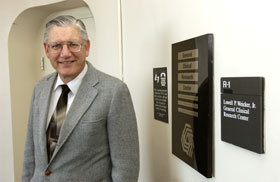Clinical Research Center Receives Federal Funds
 |
| Dr. Herbert Bonkovsky, director of the General Clinical Research Center. |
|
Photo by Peter Morenus |
The Lowell P. Weicker General Clinical Research Center has recently received a federal grant of $2.5 million to fund the second year of its most recent five-year renewal. The grant represents the center’s 12th consecutive year of funding.
“The GCRC continues to play a critical role as the cornerstone of Health Center clinical and translational research,” says Dr. Herbert Bonkovsky, director of the General Clinical Research Center.
Clinical research, according to the National Institute of Health’s (NIH) “Roadmap,” the official plan for funding and conducting research into the future, “is the linchpin of the nation’s biomedical research enterprise.”
There is also a strong emphasis at NIH on translational research.
“A major part of the NIH Roadmap is to increase the speed of moving research from the laboratory bench to the patient’s bedside,” says Bonkovsky.
From the lab to the bed is one aspect of translational research, referred to as Type 1, he explains. Another seeks to increase the movement of new knowledge and approaches from academic medical centers and their GCRC’s into surrounding communities. This is referred to as Type 2 translational research.
A third dimension of translational research, he says, is to move observations and hypotheses from the bedside back to the experimental laboratory, where more detailed studies can be performed faster and with less expense than is possible with clinical research on human subjects.
In other words, translational research is a collaborative interchange among basic and clinical investigators.
“The GCRC fosters that translation,” says Bonkovsky.
The 78 NIH-funded GCRC’s form a national network that provides settings for medical investigators to conduct safe, controlled, state-of-the-art, in-patient and out-patient studies of children and adults.
The Health Center’s GCRC was first funded in 1993 and began operating in 1994. Facilities in Farmington include six patient rooms, a treatment room, a consultation room, a laboratory, a computer center, and offices for the staff. The GCRC comprises administrative, clinical, lab, informatics, and biostatistics components.
Oversight is provided by a Scientific Advisory Committee, chaired by Victor Hesselbrock, a professor of psychiatry and director of the Alcohol Research Center. All protocols are reviewed by a planning team within the GCRC, before being submitted to the Scientific Advisory Committee.
The Health Center’s Signature Programs – research and clinical initiatives in cancer, cardiology, and musculoskeletal and bone biology – depend on the GCRC to provide the framework for bringing research findings to clinics that treat patients.
Judith Fifield, a professor of family medicine and director of the Center for Interdisciplinary Research in Women’s Health, has used the GCRC in her research, and now sits on the GCRC Scientific Advisory Committee. Her interests are especially in the area of Type 2 translational research.
“The GCRC plays a critical role in bringing research from the bench to the bedside,” she says. “The whole design of the GCRC gives investigators access to expertise and support staff.”
Fifield adds that the peer review the Scientific Advisory Committee can offer investigators if they have a new or evolving idea is “absolutely necessary for scientific investigation.”
The expertise and experience of the GCRC and its associated faculty are also important, she says, in providing oversight and assistance to junior faculty just starting their research careers.

